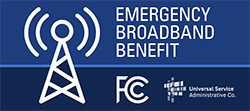 Helping Seniors Find Discounted High-Speed Internet ServicesWATCH SEGMENT ON KFOR-TV  High-speed home Internet services, which costs around $60 per month on average, can be a budget buster for many retirees living on a fixed income as well as lower-income families. Fortunately, there are resources available that can help you locate low-cost or discounted services in your area. Here’s where to begin. Internet Discounts Depending on your financial situation, a good first step to reducing your home internet costs is through the new Emergency Broadband Benefit (EBB) program which launched in May. This is a temporary federal benefit that provides a discount of up to $50 per month towards broadband service for eligible households and up to $75 per month for households on tribal lands. Eligible households can also receive a one-time discount of up to $100 to purchase a laptop, desktop computer, or tablet from participating providers if they contribute $10 to $50 toward the purchase price. To qualify, you’ll need to show that your annual household income is at or below 135 percent of the federal poverty guidelines, which is $17,388 for one person or $23,517 for two. Or, if you’re receiving certain types of government benefits such as Medicaid, food stamps (SNAP), SSI, public housing assistance, veterans’ pension or survivors pension benefit, or live on federally recognized tribal lands. Households that experienced a substantial loss of income since February 29, 2020 due to job loss or furlough can also qualify for the EBB program, as long as their household income for 2020 was at or below $99,000 for single filers and $198,000 for joint filers. To apply, go to GetEmergencyBroadband.org where you can apply online or print out an application and mail it in. Or if you’re a Cox customer, you can apply at Cox.com/ebb. If you’re already receiving assistance through the federal Lifeline benefit (see LifelineSupport.org), which is a $9.25 monthly subsidy for phone or internet costs, you automatically qualify for the EBB program, and you can receive both benefits at the same time. You can apply your EBB and your Lifeline benefit to the same or separate services.
Low-Cost Internet Created by Older Adults Technology Services from AARP (OATS) and the Humana Foundation, Aging Connected is a nationwide campaign created to help lower-income seniors find low-cost, in-home broadband options in their area. Partnering with telecommunications companies, nonprofits and public entities, Aging Connected will help you search for services in your area that provide high-speed internet at a very low cost. Most participating companies charge around $10 to $15 per month, with no contract and no equipment fee. Aging Connected also provides referrals to affordable desktop and laptop computers for under $160. To qualify, you’ll need to show that your annual household income is at or below 185 percent of the federal poverty guidelines, which is $23,800 for one person or $32,200 for two. Or, if you’re receiving certain types of government benefits similar to the EBB program. To search, go to AgingConnected.org and type in your ZIP code, name and email address, or you can call 877-745-1930.
Other Search Options |




